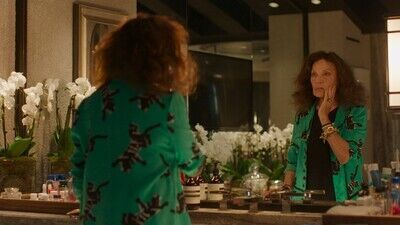The filmmakers were likely thrilled by the meticulous trove of photographs, home movies, and press clippings von Fürstenburg has maintained throughout her life. Childhood birthdays, family holidays, and teen boarding school years are assembled in cheery montages. Polaroid after Polaroid depicts Diane’s childhood in Brussels, young adulthood in London, and meeting Prince Egon von Fürstenburg, an Austrian aristocrat, while both were in college.
Their life together, as a jet-setting couple partying in Cortina, Rome, and Paris, is detailed breathlessly through newspaper archives featuring photos of the attractive couple, arm in arm, dressed to the nines. Diane held a variety of jobs before discovering she was pregnant. The pair got married, but the royals didn’t hide their disapproval of a Jewish daughter-in-law, attending only the ceremony and not the reception. Diane was subject to upsetting remarks while visiting her new husband’s family castle. “I don’t remember what was said,” Diane says. “But I do remember the conversation I had with my unborn child. ‘We will show them,’ I said. ‘We will show them.’”
The couple moves to New York; what Egon did for work is never mentioned (Wikipedia cites stints in fashion and finance), but he encouraged his wife to bring her suitcase of samples she’d made, including T-shirts and scarves. With the mentorship of Vogue editor Diana Vreeland, Diane began her own fashion house. She found inspiration in an unlikely place: Julie Nixon, defending her father on television while wearing one of Diane’s matching wrap tops and skirts. Thus, the wrap dress was born. In an era where Gloria Steinem marched in the streets, and women could only have a bank account or credit card with the approval of a male relative, the garment, marketed to women’s innate and powerful femininity, sold so well it eventually saturated the market.
As her marriage to Egon crumbled—he was openly bisexual and not shy about his many affairs—Diane ran into business troubles throughout the 1980s, her overnight fortune of millions crashing and burning until she relaunched her business at a little network called QVC. (Financial assistance/advice from second husband Barry Diller likely helped too.) Business boomed again when a new generation of women, including Paris Hilton, Michelle Obama, and Amy Winehouse, sported the wrap dress in public. Though not exactly a retiree, Diane now concentrates on her nonprofit advocacy for women making a change in the world.

